A Universe Below






A Universe Below
Almost no sunlight penetrates the thick canopy of the glow forest. As a result, organisms in this ancient biome have evolved a massive array of survival strategies using bioluminescence. Some emit light to attract mates or warn against predators. And some, strangely, illuminate themselves in order to be eaten.
More Posts from Exobiotica and Others






Interwoven
Like a giant pink warship, the Rosy Frigate punctuates the endless sea of tendrils. It hosts a crew of disk-shaped ravenous eating-machines called orbics. It is the orbics’ duty to keep the creeping tendrils from strangling and overtaking their home. Fading daylight signals their departure from the safe cluster beneath their giant companion to begin the night’s work of clearing new growth in the near vicinity. Each orbic can consume half its body weight in tube-carpet flesh every night, ensuring they will always have a place to return to at dawn. A Dwarf Blue Cortina observes the melee in confusion. Anything larger than an orbic will send it leaping away for cover, as its curiosity is matched only by its caution. The stoic quartet of Reponos standing solemnly in the background is incapable of seeing or hearing the events taking place nearby. Their role in this ecosystem turns out to be rather bizarre…

Part of a color study for the next painting I plan to start this week.



Pelagic predator pen sketch. More on this soon.



Life in the Low Forest
A relatively dry and sunny climate favors some types of forest over others. The tangled matrix of the fast-growing tube carpet forms the floor along the majority of this habitat. It grows so quickly that other species of photosynthetic creatures find it advantageous to be more mobile, lest they be crowded out and overtaken. The scarcity of water combined with the tendency towards mobility versus upward growth means this forest is relatively short in height - hence its name. There is a rich and varied food web here, with many organisms feeding on the tube carpet, keeping its ravenous growth in check. It also offers a complex labyrinth in which to hide from the many predators working tirelessly for their next meal.

Egg Chamber
In some environments, it's hard to tell the difference between genders and species. Organisms share genetic material more easily on this planet, and that leads to some complicated taxonomy. In this case, we see a group of aquatic creatures acting as nurses for a seemingly endless field of eggs. But the network of underwater chambers in which they reside is in fact another living creature. By some categorizations, it would be considered the female of the species - it produces and to some extent nourishes the field of eggs, some of which mature to be gigantic network-chambers themselves. Whether this is an extreme example of sexual dimorphism, or the result of some sort of horizontal gene transfer is a matter of conjecture at this point.
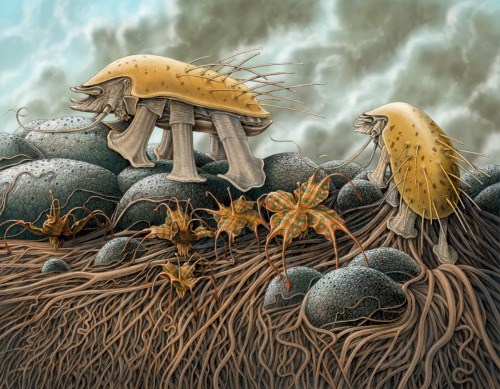
New Lands





A Giant Forest Walker
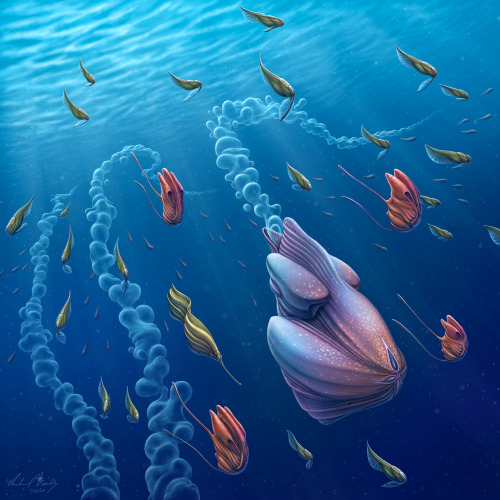
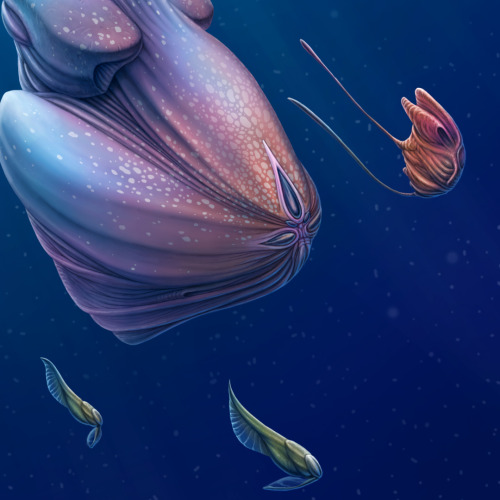
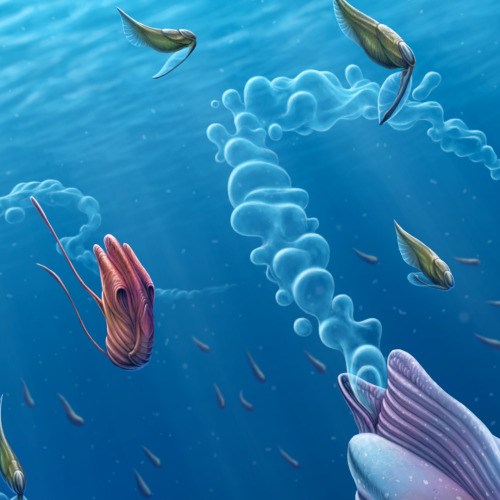
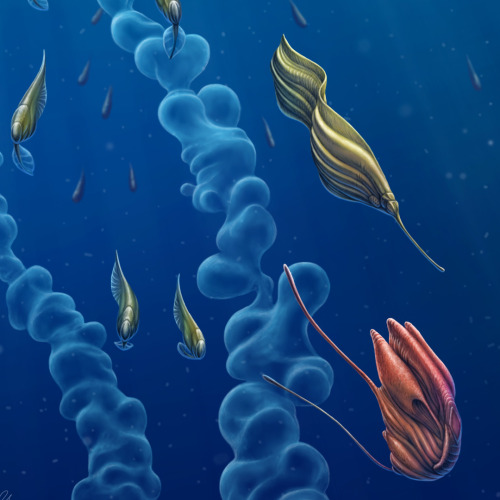
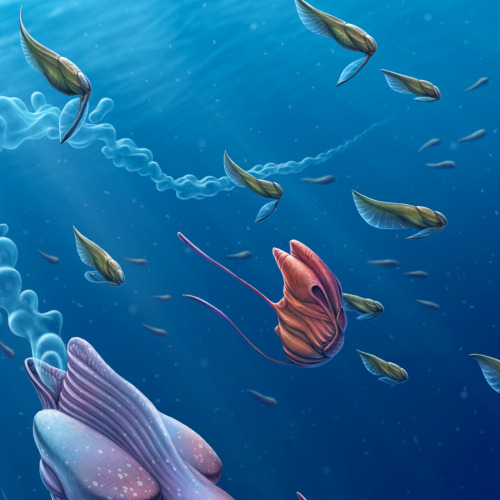
Back to the Depths
An entourage of opportunistic creatures accompanies the deep-sea behemoths during their brief ascent to the surface. Releasing their gelatinous strings of embryos here in the sunlight has a significant benefit - there's far more visibility. The swarm of followers are here in search of a quick meal in the form of the gelatin, which is full of valuable protiens and nutrients. After the feast however, the recipients of this apparent windfall become unwitting hosts for the behemoth's multitudinous offspring, which were embedded in the gel. Adapted to develop inside a wide variety of pelagic creatures, the young grow internally - and sometimes even on the surface of - their hosts until such time as they detach and sink back into the darkness. For most host species, this seems to be a mutually-beneficial symbiosis. At the beginning they receive a large and valuable meal, and usually incur very little detriment due to their temporary parasites. The young behemoths will hide in the dark depths for many years until attaining the size necessary to return to the light and repeat the ancient cycle again.
-
 glassmouths reblogged this · 6 days ago
glassmouths reblogged this · 6 days ago -
 gripies reblogged this · 1 month ago
gripies reblogged this · 1 month ago -
 anyt1ng liked this · 1 month ago
anyt1ng liked this · 1 month ago -
 potatosapien5 liked this · 1 month ago
potatosapien5 liked this · 1 month ago -
 rununcal liked this · 1 month ago
rununcal liked this · 1 month ago -
 sunsetsands reblogged this · 1 month ago
sunsetsands reblogged this · 1 month ago -
 sunsetsands liked this · 1 month ago
sunsetsands liked this · 1 month ago -
 siph-by-induction liked this · 1 month ago
siph-by-induction liked this · 1 month ago -
 sunlightedcockroach liked this · 1 month ago
sunlightedcockroach liked this · 1 month ago -
 ihaveapproximately4bones reblogged this · 1 month ago
ihaveapproximately4bones reblogged this · 1 month ago -
 mcpieandhaggis reblogged this · 1 month ago
mcpieandhaggis reblogged this · 1 month ago -
 scywritesbynight liked this · 1 month ago
scywritesbynight liked this · 1 month ago -
 p-paradoxa reblogged this · 2 months ago
p-paradoxa reblogged this · 2 months ago -
 mildkleptomania reblogged this · 2 months ago
mildkleptomania reblogged this · 2 months ago -
 memes-soul-dna liked this · 2 months ago
memes-soul-dna liked this · 2 months ago -
 fite-bite reblogged this · 2 months ago
fite-bite reblogged this · 2 months ago -
 fingerpuppetswithnoorgans reblogged this · 2 months ago
fingerpuppetswithnoorgans reblogged this · 2 months ago -
 fingerpuppetswithnoorgans liked this · 2 months ago
fingerpuppetswithnoorgans liked this · 2 months ago -
 lazysimii-blog liked this · 2 months ago
lazysimii-blog liked this · 2 months ago -
 o-phi-cassette liked this · 2 months ago
o-phi-cassette liked this · 2 months ago -
 te0-b00 liked this · 2 months ago
te0-b00 liked this · 2 months ago -
 youwillneverguessmyurl liked this · 2 months ago
youwillneverguessmyurl liked this · 2 months ago -
 spook-wolf reblogged this · 2 months ago
spook-wolf reblogged this · 2 months ago -
 godzillafandoesart liked this · 2 months ago
godzillafandoesart liked this · 2 months ago -
 supermalmoworld reblogged this · 2 months ago
supermalmoworld reblogged this · 2 months ago -
 shrlmpseven reblogged this · 2 months ago
shrlmpseven reblogged this · 2 months ago -
 beigeantlol liked this · 2 months ago
beigeantlol liked this · 2 months ago -
 combustibabe liked this · 2 months ago
combustibabe liked this · 2 months ago -
 combustibabe reblogged this · 2 months ago
combustibabe reblogged this · 2 months ago -
 cognitohazardous liked this · 2 months ago
cognitohazardous liked this · 2 months ago -
 devilishdescent reblogged this · 2 months ago
devilishdescent reblogged this · 2 months ago -
 gemevieve reblogged this · 2 months ago
gemevieve reblogged this · 2 months ago -
 haectemporasunt reblogged this · 2 months ago
haectemporasunt reblogged this · 2 months ago -
 insectivis liked this · 2 months ago
insectivis liked this · 2 months ago -
 hey-ol-soul reblogged this · 2 months ago
hey-ol-soul reblogged this · 2 months ago -
 hey-ol-soul liked this · 2 months ago
hey-ol-soul liked this · 2 months ago -
 carthus-flame-arc reblogged this · 2 months ago
carthus-flame-arc reblogged this · 2 months ago -
 sableleatherywingsopeninthe711 liked this · 2 months ago
sableleatherywingsopeninthe711 liked this · 2 months ago -
 teloles-and-friends reblogged this · 2 months ago
teloles-and-friends reblogged this · 2 months ago -
 teloles-and-friends liked this · 2 months ago
teloles-and-friends liked this · 2 months ago -
 kamakiddos liked this · 2 months ago
kamakiddos liked this · 2 months ago -
 toxxicognaths reblogged this · 2 months ago
toxxicognaths reblogged this · 2 months ago -
 toxxicognaths liked this · 2 months ago
toxxicognaths liked this · 2 months ago -
 spacebughugs reblogged this · 2 months ago
spacebughugs reblogged this · 2 months ago -
 vertekel liked this · 2 months ago
vertekel liked this · 2 months ago -
 cheshirewolff reblogged this · 2 months ago
cheshirewolff reblogged this · 2 months ago -
 redsafalloutfan liked this · 2 months ago
redsafalloutfan liked this · 2 months ago -
 sensaspecter-blog liked this · 2 months ago
sensaspecter-blog liked this · 2 months ago -
 woofzy-the-flowery-sheep-dragon liked this · 2 months ago
woofzy-the-flowery-sheep-dragon liked this · 2 months ago -
 purpleoctoeater liked this · 2 months ago
purpleoctoeater liked this · 2 months ago







